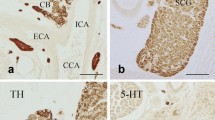Summary
Excretion and hydrostatic regulation of the Ctenophores depend on a particular set of special structures: the ciliated cell rosettes of the endodermal gastrovascular system.
The peculiarity of these cell rosettes lies in a free communication between the mesoglea and the lumen of gastrovascular canals. Rapid liquid currents, without ionic discernment, are carried through this hole. The direction of these currents is determined by the beating of the only flagellar tuft borne by the upper cellular crown of rosettes: an aqueous flow may be seen streaming across rosettes towards mesoglea when a Beroe is put in diluted sea water, whereas in concentrated sea water, the flow is streaming from mesoglea to gastrovascular cavity. A contractile diaphragm allows complete closing of the central communication of each rosette and can stop any mesogleal-gastrovascular exchange.
This activity of cell rosettes leads to an adjustment of the whole density of animal to that of external sea water.
Résumé
L'excrétion et la régulation hydrostatique des Cténaires reposent sur un ensemble qui implique un dispositif unique en son genre: les rosettes ciliées du système gastrovasculaire endodermique.
L'originalité de ces rosettes réside dans l'existence d'un puits central mettant en communication directe la mésoglée avec le contenu intravasculaire. Entre ces deux compartiments s'établissement des courants liquides rapides sans sélectivité ionique dont le sens est déterminé par le battement de la seule touffe de flagelles issus de la couronne cellulaire supérieure de la rosette. Lorsqu'une Beroe est placée en milieu marin dilué, on observe au niveau des rosettes un passage de liquide en direction de la mésoglée, alors qu'en eau de mer concentrée, un courant liquide s'établit de la mésoglée vers la lumière des canaux. L'existence d'un diaphragme contractile susceptible d'obturer complètement le puits central de chaque rosette doit permettre éventuellement d'arrêter complètement ces échanges.
Cette activité des rosettes conduit à un ajustement de la densité globale du corps de l'animal par rapport à la densité du milieu dans lequel il se trouve.
Similar content being viewed by others
Bibliographie
Burnett, A. L., Davis, E., Ruffing, F. E.: A histological and ultrastructural study of germinal differentiation of interstitial cells arising from gland cells in Hydra viridis. J. Morph. 120, 1–8 (1966).
Chapman, G.: The structure and functions of the mesoglea. In: The Cnidaria and their evolution (ed. W. J. Rees). London: Acad. Press 1960.
Chun, C.: Die Ctenophoren des Golfes von Neapel. Eine Monographie. Fauna und Flora des Golfes von Neapel, Bd. 4, 313 S. Leipzig 1880.
Cloney, R. A.: Cytoplasmic filaments and cell movements: epithelial cells during Ascidian metamorphosis. J. Ultrastruct. Res. 14, 300–328 (1966).
Coe, W. R.: The peculiar nephridia of the Nemerteans of the genus Cephalothrix. Zool. Anz. 89, 103–108 (1930).
Davis, L. E.: Differentiation of neurosensory cells in Hydra. J. Cell Sci. 5, 699–726 (1969).
Farquhar M. G., Palade, G. E.: Cell junctions in Amphibian skin. J. Cell Biol. 26, 263–291 (1965).
Fawcett, D. W.: Cilia and Flagella. In: The cell, vol. 2, p. 217–297 (eds. J. Brachet and A. E. Mirsky). New York-London: Acad. Press 1961.
Fawcett, D. W., Ito, S., Slautterback, D.: The occurrence of intercellular bridges in groups of cells exhibiting synchronous differentiation. J. biophys. biochem. Cytol. 5, 453–460 (1959).
Fleming, W. R., Hazelwood, D. H.: Ionic and osmoregulation in the fresh-water medusa, Craspedacusta sowberyi. Comp. Biochem. Physiol. 23, 911–915 (1967).
Franc, J. M.: Evolutions et interactions tissulaires au cours de la régénération des lèvres de Beroe ovata (Chamisso & Eysenhardt) Cténaire Nudicténide. Cah. Biol. Mar. 11, 57–76 (1970).
Franc, S.: Les évolutions cellulaires au cours de la régénération du pédoncule de Veretillum cynomorium Pall. Vie et Milieu 21, 1-A, 49–94 (1970).
Hadzi, J.: Eine Hypothese über die morphologische Bedeutung der sogenannten Wimperrosetten der Ctenophoren. Bull. Sci. Yougoslavie 2, 77 (1955).
Hadzi, J.: Die morphologische Bedeutung der Wimperrosetten der Ktenophoren. J. Fac. Sci. Hokkaido Univ., ser. VI, Zool. 13, 32–36 (1957).
Hazelwood, D. H., Potts, W. T. W., Fleming, W. R.: Further studies on the sodium and water metabolism of the fresh-water medusa Craspedacusta sowberyi. Z. vergl. Physiol. 67, 186–191 (1970).
Hertwig, R.: Über den Bau der Ctenophoren. Jena. Z. Naturwiss. 14, 393–547 (1880).
Hykes, O. V.: Résistance des Cténophores du genre Beroe dans l'eau de mer diluée. C. R. Soc. Biol. (Paris) 103, 355–358 (1930).
Hyman, L. H.: The invertebrates: Protozoa through Ctenophora, p. 662–696. New York: McGraw-Hill Book Company 1940.
Krumbach, Th.: Ctenophora. In: Handbuch der Zoologie von W. Kükenthal und Th. Krumbach (ed.). Berlin: W. de Gruyter & Co. 1925.
Mackay, W. C.: Sulphate regulation in jellyfish. Comp. Biochem. Physiol. 30, 481–488 (1969).
Metschnikoff, E.: Vergleichend-embryologische Studien. IV. Ueber die Gastrulation und Mesodermbildung der Ctenophoren. Z. wiss. Zool. 42, 648–656 (1885).
Reverberi, G.: Quelques nouvelles recherches expérimentales sur le développement des Cténophores. Ann. Biol. Fr. 5, 375–390 (1966).
Reynolds, E. S.: The use of lead citrate at high pH as an electron-opaque stain in electron microscopy. J. Cell Biol. 17, 208–213 (1963).
Slautterback, D. B.: Nematocyst development. In: The biology of Hydra and of some other Coelenterates (eds. Lenhoff and Loomis), p. 77–129. Coral Gables, Florida: Univ. of Miami Press 1961.
Slautterback, D. B.: Coated vesicles in absorption cells of Hydra. J. Cell Sci. 2, 563–572 (1967).
Slautterback, D. B., Fawcett, D. W.: The development of the cnidoblasts of Hydra. An electron microscope study of cell differentiation. J. biophys. biochem. Cytol. 5, 441–452 (1959).
Varigny, A. de: Notes sur l'action de l'eau douce, de la chaleur et de quelques poisons sur le Beroe ovatus. C. R. Soc. Biol. (Paris) 39, 61–63 (1887).
Wagener, G. R.: Ueber Beroe (ovatus?) und Cydippe pileus von Helgoland. Arch. Anat. Physiol. 116–133 (1866).
Zirpolo, G.: Ricerche sugli Ctenofori. 2. L'adattamento alla vita di acqua dolce. Boll. Soc. Nat. Napoli 53, 143–171 (1943).
Author information
Authors and Affiliations
Rights and permissions
About this article
Cite this article
Franc, J.M. Activités des rosettes ciliées et leurs supports ultrastructuraux chez les Cténaires. Z.Zellforsch 130, 527–544 (1972). https://doi.org/10.1007/BF00307005
Received:
Issue Date:
DOI: https://doi.org/10.1007/BF00307005



